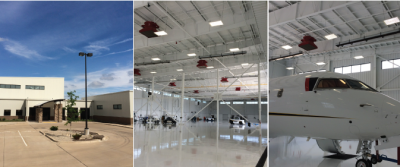Case Studies
Peerless Pump of Indianapolis has a long history of success and corporate responsibility in the American market. Its origins go back to the purchase of its existing facility from the US army in 1946. Peerless Pump is a subsidiary of Grundfos which is one of the world’s largest pump manufacturers, based in Denmark with more than 18,000 employees globally. It is through the parent companies global commitment to the reduction of energy consumption and overall carbon footprint that facilitated this project. When Energy and Safety Coordinator, Todd Walterman was tasked with this challenge he reached out locally to Freiji Engineered Systems. Frieji has a long history of leading the market in technology and performance in industrial facilities.
Chicagoland area’s McGrath Honda’s new state of the art facility desired a service area where customers could drop off their cars without facing the harsh Windy City winters. The designers recognized the function and efficiency infrared heat would provide. The hurdle was that the owner wanted the service area to be a neat, clean environment. The only overhead equipment in the space was the 42" screens keeping their customers up-to-date with the progress of their vehicle.
When the Green Bay Packers sought a solution for their practice facility they recognized a few challenges. The expansive volume of the space made them realize that any forced air solution would result in stratification sending warm air to the roof line. Anticipated temperature difference between floor level set point of 65 degrees would exceed 90 degrees at the roof where no occupants reside. Destratification fans posed issues for maintenance as well as additional energy consumption. Obviously an extremely wasteful solution.
In an effort to reduce energy consumption and improve employee comfort Chrysler sought an economical and effective solution. Chrysler’s Jefferson North Assembly Plant was concerned by the excessive energy costs they were encurring in the operation of the direct fired air heaters being used to maintain comfortable temperatures in their loading docks. During the winter heating season these door heaters operated 24 hours a day from October 7th through May 1st (206 days x 24hrs=4,944 hrs).
Volvo is world renown for its environmental consciousness, recently established a corporate goal to make all of its manufacturing facilities carbon neutral by 2012. Volvo trucks participate in the U. S. Department of Energy Industrial Technologies Save Energy Now LEADER initiative which requires manufacturers to reduce their facilities energy intensity by 2.5% per year over a 10 year time frame.
The Rickenbacker Air National Guard Base in Columbus, Ohio was not getting the results they expected from radiant heating in two large aircraft hangars on base. Upon inspection, Advanced Radiant Systems’ determined that the type of equipment installed utilized low radiant output linear units not ideally suited for the extreme heights presented by an aviation application. Complaints from occupants and maintenance personnel ranged from; “it can’t keep up when it gets real cold,” to, “when it rains outside it rains inside because of all of the roof penetrations.”
The Air Force Infrastructure Energy Strategic Plan requires the Air Force to use less energy as well as use energy more efficiently. Infrared heat may be the most effective method of heating large-volume industrial spaces such as warehouses, maintenance bays, and hangars. These facilities typically have a
high energy footprint (BTU/sq Ft) due to large infiltration loads, vehicle access requirements, poor insulation, and high ceilings. Here, forced-air heating systems are neither efficient nor effective at providing a uniform 55°F wintertime work environment for occupants.
Purdue University is internationally known as one of the top engineering schools in the world. Advanced Radiant Systems had worked with the university engineering staff on many projects. Radiant heat was a preferred solution of the facilities engineering team and they had applied it in many of their aviation as well as agriculture facilities. When they approached Advanced Radiant Systems about a planned indoor practice facility it was a perfect match. The coaching staff wanted a system that was unobtrusive to play and very quiet so they could be heard during practices. The engineering team wanted the most energy efficient system they could find.
Caterpillar is the world leader in heavy machinery excavating products. Their focus on quality and performance is paramount in their products and they require the same from their suppliers. Advanced Radiant Systems has long been a preferred vendor for Caterpillar facilities energy related projects. When the company decided to build a new facility for their corporate jets the decision was obvious.
L-3 Communications provides communication hardware for government and private aircraft worldwide - including Air Force One. L-3 has several facilities, including a maintenance and installation facility in Greenville, TX. The energy efficiency of a prior vendor was inferior to the Advanced Radiant solution. Once the advantages of our products were demonstrated on the first project, L-3 switched to Advanced Radiant Systems for all future projects.









